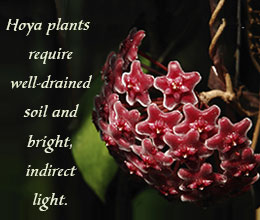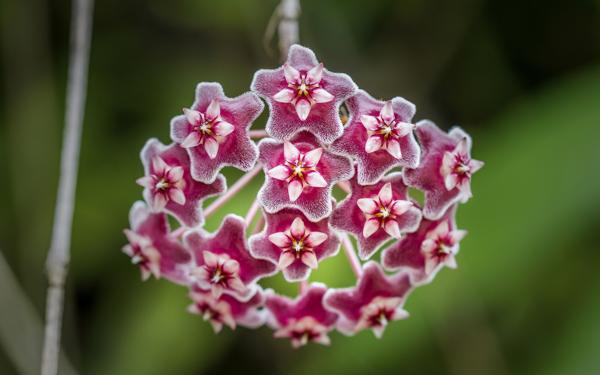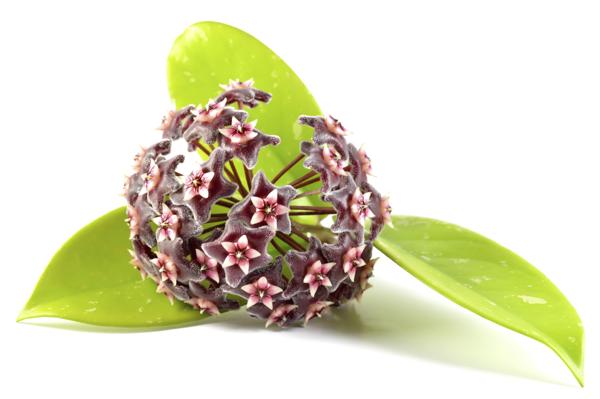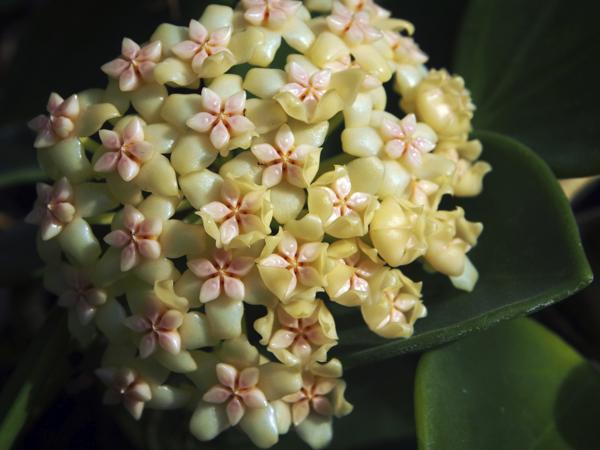Quite popular as houseplants due to their fragrant flowers and lustrous foliage, hoya plants are easy to care for. Buzzle lists out hoya plant care instructions, ranging from propagation methods to soil, water, and light requirements.

Hoya plant was named by a Scottish botanist named Robert Brown (1773-1858), who named the plant after his friend, Thomas Hoy (1750-1822), a botanist who worked as the head gardener for the Duke of Northumberland in England.Native to India, China, Thailand, Malaysia, Indonesia, and Australasia,
Hoya is a genus of more than 200 species. It belongs to the
Apocynaceae family and
Asclepiadaceae (milkweed) subfamily. It is also known by other names such as wax plant, wax flower, porcelain flowers, etc. This evergreen perennial usually grows as trailing vines, but it might also grow as shrubs. The woody stems, succulent leaves, and beautiful, fragrant, porcelain-like flowers make it an excellent choice for flower gardens. It can also thrive indoors if you provide it with the right environment.
Due to their trailing habit, hoya plants look really good in hanging baskets. If you have decided to keep this plant in your garden or indoors, you need to have an idea about the conditions that will encourage profuse flowering. If the right conditions are not provided, the plant might not bloom and the foliage might not remain succulent and healthy.Hoya Plant CareThe color, size, and shape of the flowers and the leaves would vary, depending on the species or the cultivar. Of the several species, gardening enthusiasts often opt for the cultivars of the species
Hoya carnosa. The star-shaped flowers appear in clusters that are about 2-3 inches in diameter on umbrels (umbrella-like stalks). The flowers give off a sweet scent and are very attractive. The flowers come in a variety of attractive colors.



Hoya can grow outdoors in USDA Hardiness zones 9-11. You can also keep the plant indoors. Here are some tips to take care of hoya plant.
Light
First of all, this plant does well in warm regions, but that doesn't mean that it can tolerate scorching afternoon sun. It would be best to keep the plant on an east-facing window that will receive direct sun in the morning. However, it will do well only if it gets indirect sun or bright, indirect light for the rest of the day. If you are growing the plant outdoors, make sure that the temperatures don't fall below 45°F. Ensure that it doesn't receive direct sun throughout the day. Full sun can cause the leaves to become dry or yellow.
Soil
Hoya prefers well-drained soil. It doesn't like heavy, wet soil. It is not very picky when it comes to the soil type. It will grow in different types of soils, ranging from neutral, acidic, or alkaline soils. It will even thrive in clay, sandy, or loamy soil, provided the soil drains well. So, ensure that the pot or container has drainage holes.
Watering
The leaves of this plant have the ability to hold water. Therefore, it doesn't have to be watered very frequently. Moreover, like many other plants, even hoya is susceptible to root rot. So, water the plant when the soil appears to be dry. You can place a skewer or stick in the soil to find out if the soil is dry. Water the plant more during summer and spring, and reduce the frequency of watering during winter.
Fertilizer
A deficiency of nitrogen can cause the leaves to turn pale or yellow. So, you can also choose a fertilizer that provides nitrogen, phosphorus, potassium, and other trace elements. A dilute fish emulsion or compost tea can be applied once a month to provide nutrition to the plant. Being an epiphyte, hoya derives moisture and nutrients from the air and rain. So, it would be a good idea to mist the plant with a solution made by mixing a tablespoon of fish fertilizer in a gallon of warm water.
Diseases
Mealybug, glasshouse whitefly, and scale insect can damage this plant. So, watch out for the signs of an infestation. Use a herbal insecticide to prevent and control the infestation.
Propagation
Hoya can be propagated through freshly harvested seeds or stem cuttings. Hoya seeds can be sown in a mixture of coir dust and quarry sand. Wait till the seedlings develop true leaves. Thereafter, repot the plant. If propagating through stem cuttings, use a stem cutting with two or three leaf nodes. Remove the leaves from the lower node. You can also apply a rooting hormone powder at the end of the cutting. Place the stem cutting in a small pot. Fill the pot with a commercial potting mix that contains sand, perlite, vermiculite, or pumice. Let it grow. Later, it can be transplanted to a hanging basket.Once established, hoya plants don't require a lot of care. Light pruning in early spring will suffice. Make sure that you don't deadhead or remove the flowering spurs, as flowers will form on the same spur in the next bloom season as well. It is advisable to repot the plant every few years when the plant outgrows the pot and becomes severely root-bound. Use a larger pot that has drainage holes. Make sure that the potting soil is enriched with organic matter. Follow the aforementioned instructions, and your hoya plant will be a sight to watch in the bloom season!






 Hoya plant was named by a Scottish botanist named Robert Brown (1773-1858), who named the plant after his friend, Thomas Hoy (1750-1822), a botanist who worked as the head gardener for the Duke of Northumberland in England.Native to India, China, Thailand, Malaysia, Indonesia, and Australasia, Hoya is a genus of more than 200 species. It belongs to the Apocynaceae family and Asclepiadaceae (milkweed) subfamily. It is also known by other names such as wax plant, wax flower, porcelain flowers, etc. This evergreen perennial usually grows as trailing vines, but it might also grow as shrubs. The woody stems, succulent leaves, and beautiful, fragrant, porcelain-like flowers make it an excellent choice for flower gardens. It can also thrive indoors if you provide it with the right environment.
Hoya plant was named by a Scottish botanist named Robert Brown (1773-1858), who named the plant after his friend, Thomas Hoy (1750-1822), a botanist who worked as the head gardener for the Duke of Northumberland in England.Native to India, China, Thailand, Malaysia, Indonesia, and Australasia, Hoya is a genus of more than 200 species. It belongs to the Apocynaceae family and Asclepiadaceae (milkweed) subfamily. It is also known by other names such as wax plant, wax flower, porcelain flowers, etc. This evergreen perennial usually grows as trailing vines, but it might also grow as shrubs. The woody stems, succulent leaves, and beautiful, fragrant, porcelain-like flowers make it an excellent choice for flower gardens. It can also thrive indoors if you provide it with the right environment.

 Hoya can grow outdoors in USDA Hardiness zones 9-11. You can also keep the plant indoors. Here are some tips to take care of hoya plant.Light
Hoya can grow outdoors in USDA Hardiness zones 9-11. You can also keep the plant indoors. Here are some tips to take care of hoya plant.Light